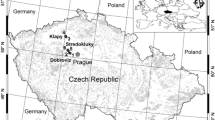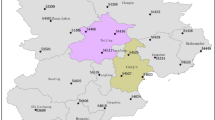Abstract
The snow is one of the most important water resources in grassland in northern and western China, while the wind blowing snow due to the strong wind there is a common phenomenon, which can lead to heavy disasters to harm the local animal husbandry and transportation. A reasonable arrangement of the snow protection forests is one of the most economical and effective methods to prevent the wind blowing snow, and a great number of investigations were carried out for its wind block effects. However, the deposition patterns of the snowfall and the blowing snow in the forests are still largely unknown. In this study, the wind tunnel experiments are performed to investigate the influences of the vegetation (grass and bush) on the wind speed profiles and the spatial distribution of the accumulated snow, by using the bran as the snow substitute. The snow blocking abilities of two bush models are analyzed to show the effects of different coverages. The results show that the grass and the bush have different effects on the wind speed profiles, and the snow-blocking abilities of the vegetation and the resulting spatial distribution are determined by the amount of the snowfall, the wind speed, and the height and the coverage of the vegetation. For the engineering design, if the snow is required on the windward side of the vegetation or in the vegetation, the densely arranged forest belts are needed, if the snow is required to accumulate on the leeward side of the vegetation, the sparse forest belts can be used. This work would be helpful as a reference to the reasonable arrangement of the snow-protection forests in pastoral areas.
Similar content being viewed by others
References
Barnett T. P., Adam J. C., Lettenmaier D. P. Potential impacts of a warming climate on water availability in snow-dominated regions [J]. Nature, 2005, 438(7066): 303–309.
Julitta T., Cremonese E., Migliavacca M. et al. Using digital camera images to analyse snowmelt and phenology of a subalpine grassland [J]. Agricultural and Forest Meteorology, 2014, 198: 116–125.
Conner L. G., Gill R. A., Harvey J. T. Earlier snowmelt accompanied by warmer soil temperatures in mid-latitude aspen forest and subalpine meadow: Implications for soil carbon [J]. Plant and Soil, 2017, 417(1): 275–285.
Tachiiri K., Shinoda M., Klinkenberg B. et al. Assessing Mongolian snow disaster risk using livestock and satellite data [J]. Journal of Arid Environments, 2008, 72(12): 2251–2263.
Begzsuren S., Ellis, J. E., Ojima D. S. et al. Livestock responses to droughts and severe winter weather in the Gobi Three Beauty National Park, Mongolia [J]. Journal of Arid Environments, 2004, 59(4): 785–796.
Inatsu M., Tanji S., Sato Y. Toward predicting expressway closures due to blowing snow events [J]. Cold Regions Science and Technology, 2020, 177: 103123.
Kotlyakov V. M., Ushakov A., Glazovsky A. Glaciers-ocean-atmosphere: interactions [M]. Wallingford, UK: IAHS Publication, 1991.
Brandle J. R., Hintz D. L., Sturrock J. W. Windbreak technology [M]. Amsterdam, The Netherlands: Elsevier, 2012.
Wang Z. Research on snow drift and its hazard control engineering in China [M]. Lanzhou, China: Lanzhou University Press, 2001(in Chinese).
Thompson J. R., Knipe O. D., Johnson P. M. Windbreaks may increase water yield from the grassland islands in Arizona’s mixed conifer forests [C]. Hydrology and water resources in Arizona and the southwest, Tempe, Arizona, USA, 1976.
Dorren L., Berger F., Imeson A. C. et al. Integrity, stability and management of protection forests in the European Alps [J]. Forest Ecology and Management, 2004, 195(1–2): 165–176.
Sakurai T., Ito Y., Takechi H. et al. Feasibility study of mitigation effects of a snowbreak wood on wind and blowing snow using optical porosity as an index [J]. Journal of Snow Engineering of Japan, 2020, 36(1): 14–22(in Japanese).
Huai W., Hu Y., Zeng Y. et al. Velocity distribution for open channel flows with suspended vegetation [J]. Advances in Water Resources, 2012, 49: 56–61.
Huai W., Wang W., Hu Y. et al. Analytical model of the mean velocity distribution in an open channel with double-layered rigid vegetation [J]. Advances in Water Resources, 2014, 69: 106–113.
Huai W., Yang L., Wang W. J. et al. Predicting the vertical low suspended sediment concentration in vegetated flow using a random displacement model [J]. Journal of Hydrology, 2019, 578: 124101.
Miri A., Dragovich D., Dong Z. Wind flow and sediment flux profiles for vegetated surfaces in a wind tunnel and field-scale windbreak [J]. Catena, 2021, 196: 104836.
Hesp P. A., Dong Y., Cheng H. et al. Wind flow and sedimentation in artificial vegetation: Field and wind tunnel experiments [J]. Geomorphology, 2019, 337: 165–182.
Wolfe S. A., Nickling W. G. Shear stress partitioning in sparsely vegetated desert canopies [J]. Earth Surface Processes and Landforms, 1996, 21(7): 607–619.
Harman I. N., Finnigan J. J. A simple unified theory for flow in the canopy and roughness sublayer [J]. Boundary-Layer Meteorology, 2007, 123(2): 339–363.
Leenders J. K., Boxel J. V., Sterk G. The effect of single vegetation elements on wind speed and sediment transport in the Sahelian zone of Burkina Faso [J]. Earth Surface Processes and Landforms: The Journal of the British Geomorphological Research Group, 2007, 32(10): 1454–1474.
Huai W. X., Li S., Katul G. G. et al. Flow dynamics and sediment transport in vegetated rivers: A review [J]. Journal of Hydrodynamics, 2021, 33(3): 400–420.
Hiemstra C. A., Liston G. E., Reiners W. A. Snow redistribution by wind and interactions with vegetation at upper treeline in the Medicine Bow Mountains, Wyoming, USA [J]. Arctic, Antarctic, and Alpine Research, 2002, 34(3): 262–273.
Zuo H., Yan M., Liu B. et al. Snow cover morphology and snowbound capacity of Achnatherum splendens shrub in typical grassland areas [J]. Journal of Glaciology and Geocryology, 2016, 38(3): 725–731.
Torita H. Effect of shelterbelt structure on wind reduction and meteorological damage [J]. Bulletin of the Hokkaido Forestry Research Institute, 2009, 46: 1–51(in Japanese).
Yamazaki T., Sumita N., Nakamura R. Scale model of snowbreak woods and PIV in wind tunnel experiment using model snow [C]. The Snow and Ice Research Conference, Hachinohe, Japan, 2014(in Japanese).
Zhang J., Shao Y., Huang N. Measurements of dust deposition velocity in a wind-tunnel experiment [J]. Atmospheric Chemistry and Physics, 2014, 14(17): 8869–8882.
Nishimura K., Nemoto M. Blowing snow at Mizuho station, Antarctica [J]. Philosophical Transactions of the Royal Society A: Mathematical, Physical and Engineering Sciences, 2005, 363(1832): 1647–1662.
Nemoto M., Nishumura K. Direct measurement of shear stress during snow saltation [J]. Boundary-Layer Meteorology, 2001, 100(1): 149–170.
Kang L., Zhang J., Zou X. et al. Experimental investigation of the aerodynamic roughness length for flexible plants [J]. Boundary-Layer Meteorology, 2019, 172(3): 397–416.
Tang C., Lei J., Nepf H. M. Impact of vegetation-generated turbulence on the critical, near-bed, wave-velocity for sediment resuspension [J]. Water Resources Research, 2019, 55(7): 5904–5917.
Acknowledgements
This work was supported by the Second Tibetan Plateau Scientific Expedition and Research Program (Grant No. 2019QZKK020109-2, 2019QZKK020611), the Fundamental Research Funds for the Central Universities (Grant No. lzujbky-2020-pd11).
Author information
Authors and Affiliations
Corresponding author
Additional information
Project supported by the National Natural Science Foundation of China (Grant Nos. 41931179, 42006187).
Biography
Guang Li (1988-), Male, Ph. D.
Rights and permissions
About this article
Cite this article
Li, G., Qin, Jm., Yu, Hx. et al. Wind-tunnel experimental studies of the spatial snow distribution over grass and bush surfaces. J Hydrodyn 34, 85–93 (2022). https://doi.org/10.1007/s42241-022-0009-4
Received:
Revised:
Accepted:
Published:
Issue Date:
DOI: https://doi.org/10.1007/s42241-022-0009-4




